Life Cycle Assessment of Substitutive Building Materials for Landfill Capping Systems in Vietnam
Abstract
:1. Introduction
2. Materials and Methods
2.1. Prefeasibility Analysis: Soil Mechanical Test
- Selection of potential materials that are available in large amounts in Vietnam and are considered residues based on literature research;
- Procurement of these materials and performance of a general soil mechanical characterisation of the pure materials;
- Development of mixture scenarios for the materials based on their properties and existing experiences;
- Soil mechanical investigations for several mixture scenarios to assess feasible mixtures that meet the requirements of the existing legislation on landfill sealing layers;
- Those mixtures that met the legal requirements for landfill sealing layers in terms of hydraulic conductivity have been considered for potential implementation and, in this regard, for the LCA.
2.2. LCA
- -
- goal and scope definition;
- -
- life cycle inventory;
- -
- life cycle impact assessment;
- -
- interpretation.
2.2.1. Goal and Scope
2.2.2. Functional Unit
2.2.3. Life Cycle Inventory
2.2.4. Life Cycle Impact Assessment
3. Results and Discussions
3.1. Soil Mechanics Result
- w (-) water content
- ρs (g/cm3) installation density
- ρPr (g/cm3) proctor density
- wPr (-) Water content at proctor density
- kf (m/s) hydraulic permeability
- FC (%) usable field capacity
- AC (%) air capacity
3.2. LCA Analysis
3.3. Future Outlook of Implementation of Waste Materials
3.4. Limitation
4. Conclusions
Supplementary Materials
Author Contributions
Funding
Institutional Review Board Statement
Informed Consent Statement
Data Availability Statement
Acknowledgments
Conflicts of Interest
References
- Rajoo, K.S.; Karam, D.S.; Ismail, A.; Arifin, A. Evaluating the leachate contamination impact of landfills and open dumpsites from developing countries using the proposed Leachate Pollution Index for Developing Countries (LPIDC). Environ. Nanotechnol. Monit. Manag. 2020, 14, 100372. [Google Scholar] [CrossRef]
- Vaverková, M.D.; Adamcová, D.; Radziemska, M.; Voběrková, S.; Mazur, Z.; Zloch, J. Assessment and Evaluation of Heavy Metals Removal from Landfill Leachate by Pleurotus ostreatus. Waste Biomass Valorization 2017, 9, 503–511. [Google Scholar] [CrossRef]
- Le, T.S.; Dang, N.M.; Tran, D.T. Performance of coupling electrocoagulation and biofiltration processes for the treatment of leachate from the largest landfill in Hanoi, Vietnam: Impact of operating conditions. Sep. Purif. Technol. 2021, 255, 117677. [Google Scholar] [CrossRef]
- Parameswari, K.; Al Aamri, A.M.S.; Gopalakrishnan, K.; Arunachalam, S.; Al Alawi, A.A.S.; Sivasakthivel, T. Sustainable landfill design for effective municipal solid waste management for resource and energy recovery. Mater. Today Proc. 2021, 47, 2441–2449. [Google Scholar] [CrossRef]
- Feng, S.J.; Zhao, Y.; Zhang, X.L.; Bai, Z.B. Leachate leakage investigation, assessment and engineering countermeasures for tunneling underneath a MSW landfill. Eng. Geol. 2020, 265, 105447. [Google Scholar] [CrossRef]
- Osinowo, O.O.; Falufosi, M.O.; Omiyale, E.O. Integrated electromagnetic (EM) and Electrical Resistivity Tomography (ERT) geophysical studies of environmental impact of Awotan dumpsite in Ibadan, southwestern Nigeria. J. Afr. Earth Sci. 2018, 140, 42–51. [Google Scholar] [CrossRef]
- Rubinos, D.A.; Spagnoli, G. Utilization of waste products as alternative landfill liner and cover materials—A critical review. Crit. Rev. Environ. Sci. Technol. 2018, 48, 376–438. [Google Scholar] [CrossRef]
- Osinubi, K.J.; Eberemu, A.O. Hydraulic conductivity of compacted lateritic soil treated with bagasse ash. Int. J. Environ. Waste Manag. 2013, 11, 38–58. [Google Scholar] [CrossRef]
- Devarangadi, M. Correlation studies on geotechnical properties of various industrial byproducts generated from thermal power plants, iron and steel industries as liners in a landfill—A detailed review. J. Clean. Prod. 2020, 261, 121207. [Google Scholar] [CrossRef]
- Jiao, H.; Wu, Y.; Wang, H.; Chen, X.; Li, Z.; Wang, Y.; Zhang, B.; Liu, J. Micro-scale mechanism of sealed water seepage and thickening from tailings bed in rake shearing thickener. Miner. Eng. 2021, 173, 107043. [Google Scholar] [CrossRef]
- Andreas, L.; Diener, S.; Lagerkvist, A. Steel slags in a landfill top cover—Experiences from a full-scale experiment. Waste Manag. 2014, 34, 692–701. [Google Scholar] [CrossRef] [PubMed] [Green Version]
- Kim, B.; Prezzi, M.; Salgado, R. Geotechnical Properties of Fly and Bottom Ash Mixtures for Use in Highway Embankments. J. Geotech. Geoenviron. Eng. 2005, 131, 914–924. [Google Scholar] [CrossRef]
- Herrmann, I. Use of Secondary Construction Material in Landfill Cover Liners. Ph.D. Thesis, Luleå Tekniska Universitet, Luleå, Sweden, 2006. [Google Scholar]
- Colomer Mendoza, F.J.; Esteban Altabella, J.; Gallardo Izquierdo, A. Application of inert wastes in the construction, operation and closure of landfills: Calculation tool. Waste Manag. 2017, 59, 276–285. [Google Scholar] [CrossRef] [PubMed] [Green Version]
- Fořt, J.; Černý, R. Transition to circular economy in the construction industry: Environmental aspects of waste brick recycling scenarios. Waste Manag. 2020, 118, 510–520. [Google Scholar] [CrossRef] [PubMed]
- Mishra, A.K.; Ravindra, V. On the Utilization of Fly Ash and Cement Mixtures as a Landfill Liner Material. Int. J. Geosynth. Ground Eng. 2015, 1, 17. [Google Scholar] [CrossRef] [Green Version]
- Behera, B.; Mishra, M.K. California Bearing Ratio and Brazilian Tensile Strength of Mine Overburden-Fly Ash-Lime Mixtures for Mine Haul Road Construction. Geotech. Geol. Eng. 2012, 30, 449–459. [Google Scholar] [CrossRef]
- Gupt, C.B.; Bordoloi, S.; Sekharan, S.; Sarmah, A.K. A feasibility study of Indian fly ash-bentonite as an alternative adsorbent composite to sand-bentonite mixes in landfill liner. Environ. Pollut. 2020, 265, 114811. [Google Scholar] [CrossRef]
- Gallagher, L.; Golev, A.; Vander Velpen, A.; Stringer, M.; Friot, D.; Reimer Lynggaard, J.; Franks, D.M.; Franks, D.; Arbelaez-Ruiz, D.; Chuah, S. Alternative Sand from Mineral Ores: A Potential New Solution to the Global Sand Sustainability Crisis—Interim Report; UNEP: Geneva, Switzerland, 2021. [Google Scholar]
- Widomski, M.K.; Broichsitter, S.B.; Zink, A.; Fleige, H.; Horn, R.; Stepniewski, W. Numerical modeling of water balance for temporary landfill cover in North Germany. J. Plant Nutr. Soil Sci. 2015, 178, 401–412. [Google Scholar] [CrossRef]
- Travar, I.; Andreas, L.; Kumpiene, J.; Lagerkvist, A. Development of drainage water quality from a landfill cover built with secondary construction materials. Waste Manag. 2015, 35, 148–158. [Google Scholar] [CrossRef] [Green Version]
- Simon, F.G.; Müller, W.W. Standard and alternative landfill capping design in Germany. Environ. Sci. Policy 2004, 7, 277–290. [Google Scholar] [CrossRef]
- Scottish Environment Protection Agency (SEPA). Framework for Risk Assessment for Landfill Sites the Geological Barrier, Mineral Layer and the Leachate Sealing and Drainage System Framework for Risk Assessment for Landfill Sites; SEPA: Stirling, UK, 2002. [Google Scholar]
- Dajić, A.; Mihajlović, M.; Jovanović, M.; Karanac, M.; Stevanović, D.; Jovanović, J. Landfill design: Need for improvement of water and soil protection requirements in EU Landfill Directive. Clean Technol. Environ. Policy 2016, 18, 753–764. [Google Scholar] [CrossRef]
- Landfill Guidance Group UK. Design of Capping Systems Landfill Guidance Group Industry Code of Practice No. LGG 111; Landfill Guidance Group UK: London, UK, 2018. [Google Scholar]
- Ramke, H.-G. Appropriate Design and Operation of Sanitary Landfills. In Proceedings of the International Conference on Sustainable Economic Development and Sound Resource Management in Central Asia, Almaty, Kazakhstan, 19–21 September 2001. [Google Scholar]
- Jaisi, D.P.; Glawe, U.; Bergado, D.T. Hydraulic behaviour of geosynthetic and granular landfill drainage materials in the Sa Kaeo landfill, Thailand. Geotext. Geomembr. 2005, 23, 185–204. [Google Scholar] [CrossRef]
- Beck-Broichsitter, S.; Fleige, H.; Horn, R. Compost quality and its function as a soil conditioner of recultivation layers—A critical review. Int. Agrophys. 2018, 32, 11–18. [Google Scholar] [CrossRef] [Green Version]
- Beck-Broichsitter, S.; Gerke, H.H.; Horn, R. Assessment of Leachate Production from a Municipal Solid-Waste Landfill through Water-Balance Modeling. Geosciences 2018, 8, 372. [Google Scholar] [CrossRef] [Green Version]
- Tauber, H. Alternative Abdichtungssysteme von Deponien Alternative Abdichtungssysteme von Deponien unter Verwertung von Abfällen am Praktischen Beispiel des Großversuches der Deponie “Grube Siegfried”; MUEG Mitteldeutsche Umwelt- und Entsorgung GmbH: Braunsbedra, Germany, 2005. [Google Scholar]
- Climate Vietnam—Climate Tables & Holiday Destinations. 2021. Available online: https://www.wetter.de/klima/asien/vietnam-c9901.html (accessed on 2 August 2021).
- Schneider, P.; Lämmel, A.; Schmitt, A.; Nam, N.P.; Anh, L.H. Current and future solid waste management system in Northern Viet Nam with focus on Ha Noi: Climate change effects and landfill management. J. Mater. Cycles Waste Manag. 2016, 19, 1106–1116. [Google Scholar] [CrossRef]
- General Statistics Office of Vietnam. 2018. Available online: https://www.gso.gov.vn/default_en.aspx?tabid=774 (accessed on 23 July 2020).
- Ministry of Planning and Investment. Population Projections for Vietnam 2009–2049; General Statistics Office: Hanoi, Vietnam, 2011. [Google Scholar]
- Naveedh Ahmed, S.; Anh, L.H.; Schneider, P. A DPSIR Assessment on Ecosystem Services Challenges in the Mekong Delta, Vietnam: Coping with the Impacts of Sand Mining. Sustainability 2020, 12, 9323. [Google Scholar]
- Bui, L.T.; Nguyen, P.H. Integrated model for methane emission and dispersion assessment from landfills: A case study of Ho Chi Minh City, Vietnam. Sci. Total Environ. 2020, 738, 139865. [Google Scholar] [CrossRef]
- Tong, Y.D.; Huynh, T.D.X.; Khong, T.D. Understanding the role of informal sector for sustainable development of municipal solid waste management system: A case study in Vietnam. Waste Manag. 2021, 124, 118–127. [Google Scholar] [CrossRef]
- Schneider, P.; Anh, L.H.; Wagner, J.; Reichenbach, J.; Hebner, A. Solid Waste Management in Ho Chi Minh City, Vietnam: Moving towards a Circular Economy? Sustainability 2017, 9, 286. [Google Scholar] [CrossRef] [Green Version]
- Tsai, F.M.; Bui, T.D.; Tseng, M.L.; Wu, K.J. A causal municipal solid waste management model for sustainable cities in Vietnam under uncertainty: A comparison. Resour. Conserv. Recycl. 2020, 154, 104599. [Google Scholar] [CrossRef]
- Dieu, T.T.M.; Oanh, L.T.K. Possibilities and Challenges to Approach Zero-disposal of Biodegradable Organic Domestic Solid Waste in Ho Chi Minh City, Vietnam. Int. J. Innov. Sci. Eng. Technol. 2015, 2, 668–675. [Google Scholar]
- World Bank. Solid and Industrial Hazardous Waste Management Assessment; World Bank: Washington, DC, USA, 2018. [Google Scholar]
- FAO. Rice Market Monitor; FAO: Roma, Italy, 2018. [Google Scholar]
- Eberemu, A.O.; Amadi, A.A.; Osinubi, K.J. The Use of Compacted Tropical Clay Treated with Rice Husk Ash as a Suitable Hydraulic Barrier Material in Waste Containment Applications. Waste Biomass Valorization 2013, 2, 309–323. [Google Scholar] [CrossRef]
- Moraes, C.A.M.; Fernandes, I.J.; Calheiro, D.; Kieling, A.G.; Brehm, F.A.; Rigon, M.R.; Berwanger Filho, J.A.; Schneider, I.A.H.; Osorio, E. Review of the rice production cycle: By-products and the main applications focusing on rice husk combustion and ash recycling. Waste Manag. Res. 2014, 32, 1034–1048. [Google Scholar] [CrossRef] [PubMed]
- Hong HT, V.; Ahn, J.W. Overview of coal-fired power plant ash situation and cement industry in Vietnam. J. Energy Eng. 2018, 27, 57–62. [Google Scholar]
- ASEAN Post. Vietnam’s Growing Demand for Energy. The ASEAN Post, 10 April 2019. [Google Scholar]
- Mollamahmutoǧlu, M.; Yilmaz, Y. Potential use of fly ash and bentonite mixture as liner or cover at waste disposal areas. Environ. Geol. 2001, 40, 1316–1324. [Google Scholar] [CrossRef]
- Herrmann, I.; Svensson, M.; Ecke, H.; Kumpiene, J.; Maurice, C.; Andreas, L.; Lagerkvist, A. Hydraulic conductivity of fly ash–sewage sludge mixes for use in landfill cover liners. Water Res. 2009, 43, 3541–3547. [Google Scholar] [CrossRef]
- Joshi, R.C.; Hettiaratchi, J.P.A.; Achari, G. Properties of modified Alberta fly ash in relation to utilization in waste management applications. Can. J. Civ. Eng. 1994, 21, 419–426. [Google Scholar] [CrossRef]
- Phanikumar, B.R.; Shankar, M.U. Heave Studies on Fly Ash-Stabilised Expansive Clay Liners. Geotech. Geol. Eng. 2016, 35, 111–120. [Google Scholar] [CrossRef]
- Deka, A.; Sekharan, S. Contaminant retention characteristics of fly ash-bentonite mixes. Waste Manag. Res. 2017, 35, 40–46. [Google Scholar] [CrossRef]
- Hoang, N.H.; Ishigaki, T.; Kubota, R.; Tong, T.K.; Nguyen, T.T.; Nguyen, H.G.; Yamada, M.; Kawamoto, K. Waste generation, composition, and handling in building-related construction and demolition in Hanoi, Vietnam. Waste Manag. 2020, 117, 32–41. [Google Scholar] [CrossRef]
- Asian Development Bank. Metabilism of Six Asian Cities; Asian Development Bank: Manila, Philippines, 2014. [Google Scholar]
- Rodríguez-Robles, D.; García-González, J.; Juan-Valdés, A.; Morán-Del Pozo, J.M.; Guerra-Romero, M.I. Quality Assessment of Mixed and Ceramic Recycled Aggregates from Construction and Demolition Wastes in the Concrete Manufacture According to the Spanish Standard. Materials 2014, 7, 5843–5857. [Google Scholar] [CrossRef] [PubMed] [Green Version]
- Morgenstern, N.R.; Fair, A.E.; McRoberts, E.C. Geotechnical engineering beyond soil mechanics—A case study. Can. Geotech. J. 1988, 25, 637–661. [Google Scholar] [CrossRef]
- Smith, M.J. Soil Mechanics, 4th ed.; Routledge: New York, NY, USA, 1981. [Google Scholar]
- Bundesministerium für Umwelt, Naturschutz. Verordnung über Deponien und Langzeitlager (Deponieverordnung-DepV); Bundesministerium für Umwelt, Naturschutz: Berlin, Germany, 2009. [Google Scholar]
- Elhakim, A.F. Estimation of soil permeability. Alex. Eng. J. 2016, 55, 2631–2638. [Google Scholar] [CrossRef] [Green Version]
- Zabielska-Adamska, K. Fly Ash as a Barrier Material. In Proceedings of the Geo-Frontiers Congress 2011, Dallas, TX, USA, 13–16 March 2011; American Society of Civil Engineers: Dallas, TX, USA, 2011; pp. 947–956. [Google Scholar]
- Wasil, M. Effect of Bentonite Addition on the Properties of Fly Ash as a Material for Landfill Sealing Layers. Appl. Sci. 2020, 10, 1488. [Google Scholar] [CrossRef] [Green Version]
- ISO. Environmental Management—Life Cycle Assessment—Principles and Framework; ISO: Geneva, Switzerland, 2006. [Google Scholar]
- Guinee, J.B. Handbook on life cycle assessment operational guide to the ISO standards. Int. J. Life Cycle Assess. 2002, 7, 311–313. [Google Scholar] [CrossRef]
- UNEP. Lifecycle Initiative. Global Guidance Life Cycle Impact on Environmental Indicators Assessment; UNCP: Nairobi, Kenya, 2019; Volume 2. [Google Scholar]
- Hospido, A.; Rodríguez, H. Life Cycle Assessment (LCA) of Ionic Liquids. In Encyclopedia of Ionic Liquids; Zhang, S., Ed.; Springer: Singapore, 2019; pp. 1–9. ISBN 978-981-10-6739-6. [Google Scholar]
- Marinković, S.; Radonjanin, V.; Malešev, M.; Ignjatović, I. Comparative environmental assessment of natural and recycled aggregate concrete. Waste Manag. 2010, 30, 2255–2264. [Google Scholar] [CrossRef]
- Turk, J.; Cotič, Z.; Mladenovič, A.; Šajna, A. Environmental evaluation of green concretes versus conventional concrete by means of LCA. Waste Manag. 2015, 45, 194–205. [Google Scholar] [CrossRef]
- Ziegler-Rodriguez, K.; Margallo, M.; Aldaco, R.; Vázquez-Rowe, I.; Kahhat, R. Transitioning from open dumpsters to landfilling in Peru: Environmental benefits and challenges from a life-cycle perspective. J. Clean. Prod. 2019, 229, 989–1003. [Google Scholar] [CrossRef]
- Gursel, A.P.; Ostertag, C. Life-Cycle Assessment of High-Strength Concrete Mixtures with Copper Slag as Sand Replacement. Adv. Civ. Eng. 2019, 2019, 6815348. [Google Scholar] [CrossRef]
- Emami, N.; Heinonen, J.; Marteinsson, B.; Säynäjoki, A.; Junnonen, J.M.; Laine, J.; Junnila, S. A life cycle assessment of two residential buildings using two different LCA database-software combinations: Recognizing uniformities and inconsistencies. Buildings 2019, 9, 20. [Google Scholar] [CrossRef] [Green Version]
- Dahlbo, H.; Koskela, S.; Pihkola, H.; Nors, M.; Federley, M.; Seppälä, J. Comparison of different normalised LCIA results and their feasibility in communication. Int. J. Life Cycle Assess. 2012, 18, 850–860. [Google Scholar] [CrossRef]
- SIMETRIC. Density of Materials—Bulk Materials. 2014. Available online: https://www.simetric.co.uk/si_materials.htm (accessed on 16 August 2021).
- Kaufhold, S.; Plötze, M.; Klinkenberg, M.; Dohrmann, R. Density and porosity of bentonites. J. Porous Mater. 2013, 20, 191–208. [Google Scholar] [CrossRef]
- Kasinikota, P.; Tripura, D.D. Evaluation of compressed stabilized earth block properties using crushed brick waste. Constr. Build. Mater. 2021, 280, 122520. [Google Scholar] [CrossRef]
- Kantesaria, N.; Chandra, P.; Sachan, A. Geotechnical Behaviour of Fly Ash-Bentonite Mixture as a Liner Material. In Lecture Notes in Civil Engineering, Proceedings of the Indian Geotechnical Conference 2019, Surat, India, 19–21 December 2019; Springer: Singapore, 2019. [Google Scholar]
- Fly Ash Resource Centre (FARC); State Pollution Control Board, Odisha. Fly Ash Utilisation in Road Construction; State Pollution Control Board, Odisha: Bhubaneswar, India, 2015. [Google Scholar]
- Pode, R. Potential applications of rice husk ash waste from rice husk biomass power plant. Renew. Sustain. Energy Rev. 2016, 53, 1468–1485. [Google Scholar] [CrossRef]
- Wernet, G.; Bauer, C.; Steubing, B.; Reinhard, J.; Moreno-Ruiz, E.; Weidema, B. The ecoinvent database version 3 (part I): Overview and methodology. Int. J. Life Cycle Assess. 2016, 21, 1218–1230. [Google Scholar] [CrossRef]
- Säynäjoki, A.; Heinonen, J.; Junnila, S.; Horvath, A. Can life-cycle assessment produce reliable policy guidelines in the building sector? Environ. Res. Lett. 2017, 12, 013001. [Google Scholar] [CrossRef] [Green Version]
- Silvestre, J.D.; De Brito, J.; Pinheiro, M.D. Environmental impacts and benefits of the end-of-life of building materials—Calculation rules, results and contribution to a “cradle to cradle” life cycle. J. Clean. Prod. 2014, 66, 37–45. [Google Scholar] [CrossRef]
- Ghanbari, M.; Abbasi, A.M.; Ravanshadnia, M. Production of natural and recycled aggregates: The environmental impacts of energy consumption and CO2 emissions. J. Mater. Cycles Waste Manag. 2017, 20, 810–822. [Google Scholar] [CrossRef]
- Yazdanbakhsh, A.; Lagouin, M. The effect of geographic boundaries on the results of a regional life cycle assessment of using recycled aggregate in concrete. Resour. Conserv. Recycl. 2019, 143, 201–209. [Google Scholar] [CrossRef]
- Consoli, F. Guidelines for Life-Cycle Assessment: A Code of Practice; Society of Environmental Toxicology and Chemistry: Brussels, Belgium, 1993. [Google Scholar]
- Goedkoop, M.; Heijungs, R.; De Schryver, A.; Struijs, J.; Van Zelm, R. ReCiPe 2008: A Life Cycle Impact Assessment Method Which Comprises Harmonised Category Indicators at the Midpoint and the Endpoint Level, 1st ed.; Report I: Characterisation Mark Huijbregts 3; Ministry of Housing, Spatial Planning and Environment (VROM): The Hague, The Netherlands, 2009. [Google Scholar]
- Messmann, L.; Helbig, C.; Thorenz, A.; Tuma, A. Economic and environmental benefits of recovery networks for WEEE in Europe. J. Clean. Prod. 2019, 222, 655–668. [Google Scholar] [CrossRef]
- Huijbregts, M.A.J.; Steinmann, Z.J.N.; Elshout, P.M.F.; Stam, G.; Verones, F.; Vieira, M.; Zijp, M.; Hollander, A.; van Zelm, R. ReCiPe2016: A harmonised life cycle impact assessment method at midpoint and endpoint level. Int. J. Life Cycle Assess. 2017, 22, 138–147. [Google Scholar] [CrossRef]
- Frischknecht, R.; Jungbluth, N.; Althaus, H.-J.; Doka, G.; Dones, R.; Hirschier, R.; Hellweg, S.; Humbert, S.; Margni, M.; Nemecek, T.; Spielmann, M. Implementation of Life Cycle Impact Assessment Methods; Ecoinvent report No. 3; Swiss Centre for Life Cycle Inventories: Dübendorf, Switzerland, 2004. [Google Scholar]
- Jørgensen, AM.M.; Ywema, P.E.; Frees, N.; Exner, S.; Bracke, R. Transportation in LCA. Int. J. LCA 1996, 1, 218–220. [Google Scholar] [CrossRef]
- Knoeri, C.; Sanyé-Mengual, E.; Althaus, H.J. Comparative LCA of recycled and conventional concrete for structural applications. Int. J. Life Cycle Assess. 2013, 18, 909–918. [Google Scholar] [CrossRef] [Green Version]
- Zabalza Bribián, I.; Valero Capilla, A.; Aranda Usón, A. Life cycle assessment of building materials: Comparative analysis of energy and environmental impacts and evaluation of the eco-efficiency improvement potential. Build. Environ. 2011, 46, 1133–1140. [Google Scholar] [CrossRef]
- Güereca, L.P.; Jato-Espino, D.; Lizasoain-Arteaga, E. Life-Cycle Assessment of Construction Materials: Analysis of Environmental Impacts and Recommendations of Eco-Efficient Management Practices. In Handbook of Environmental Materials Management; Springer: Cham, Switzerland, 2018; pp. 1–37. [Google Scholar]
- IEA. Viet Nam—Countries & Regions—IEA; IEA: Paris, France, 2019. [Google Scholar]
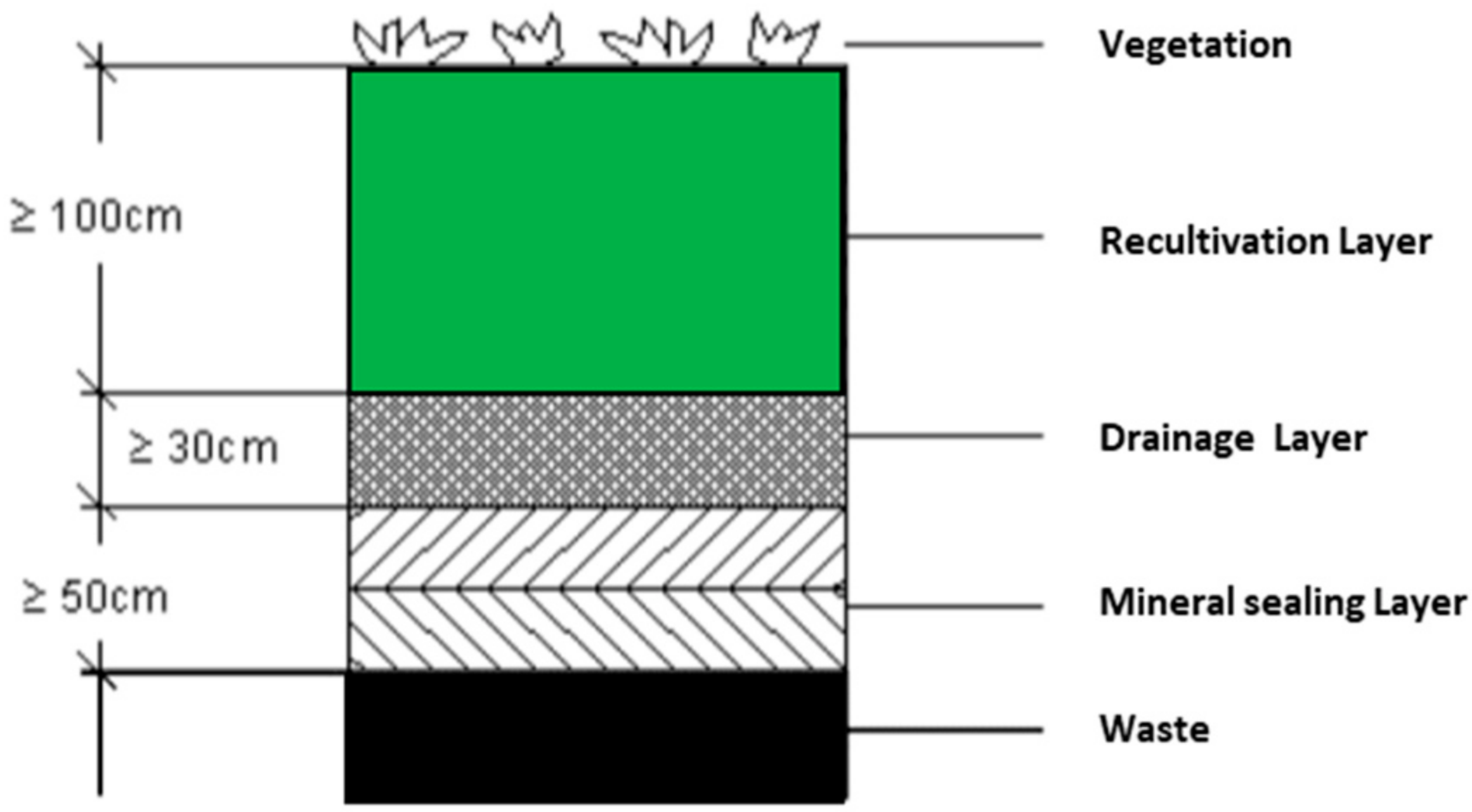




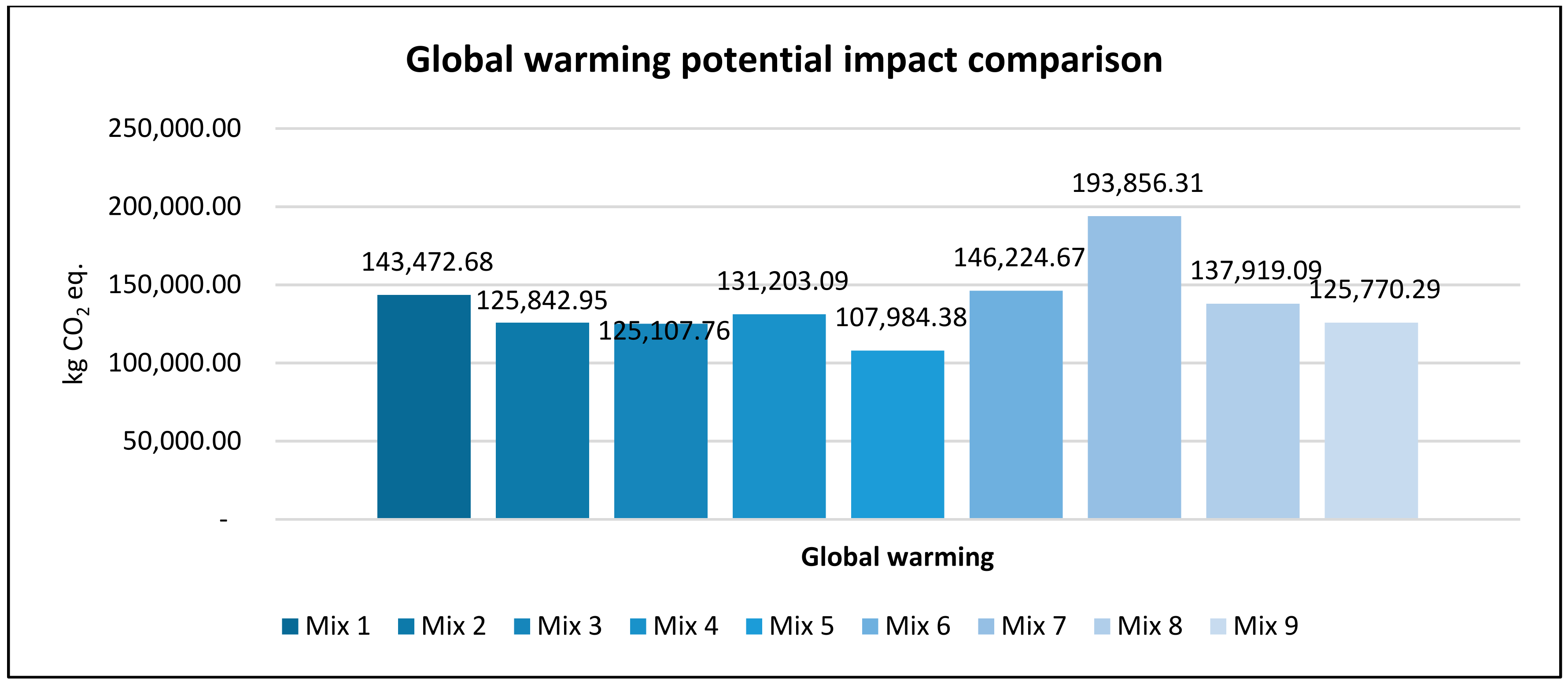
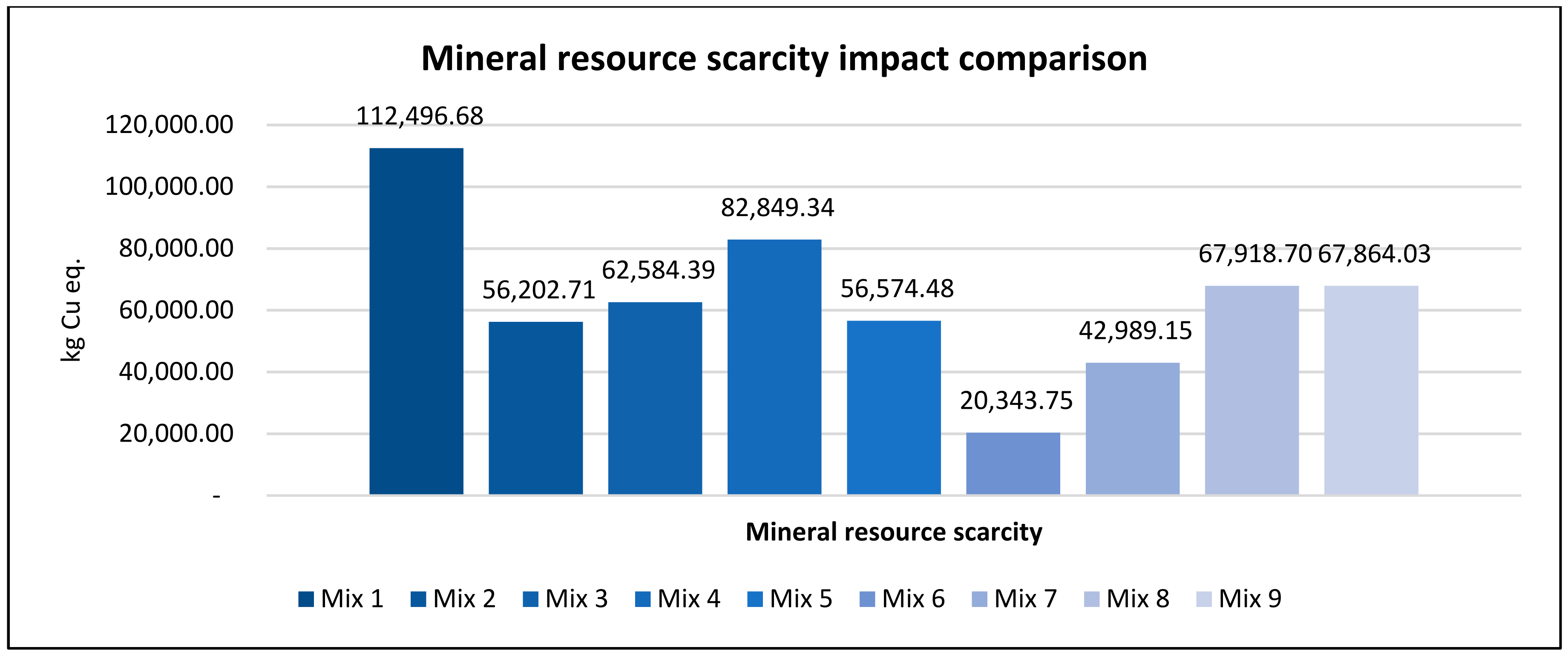
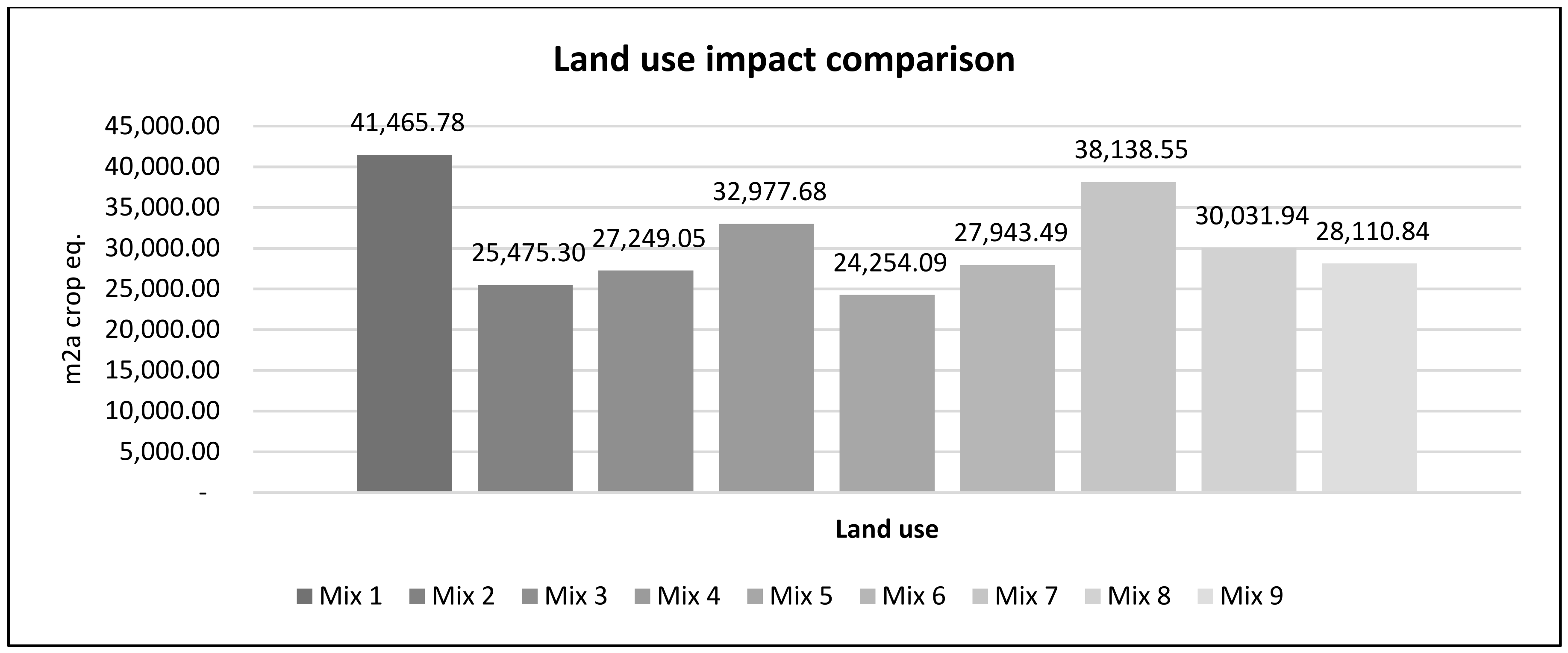

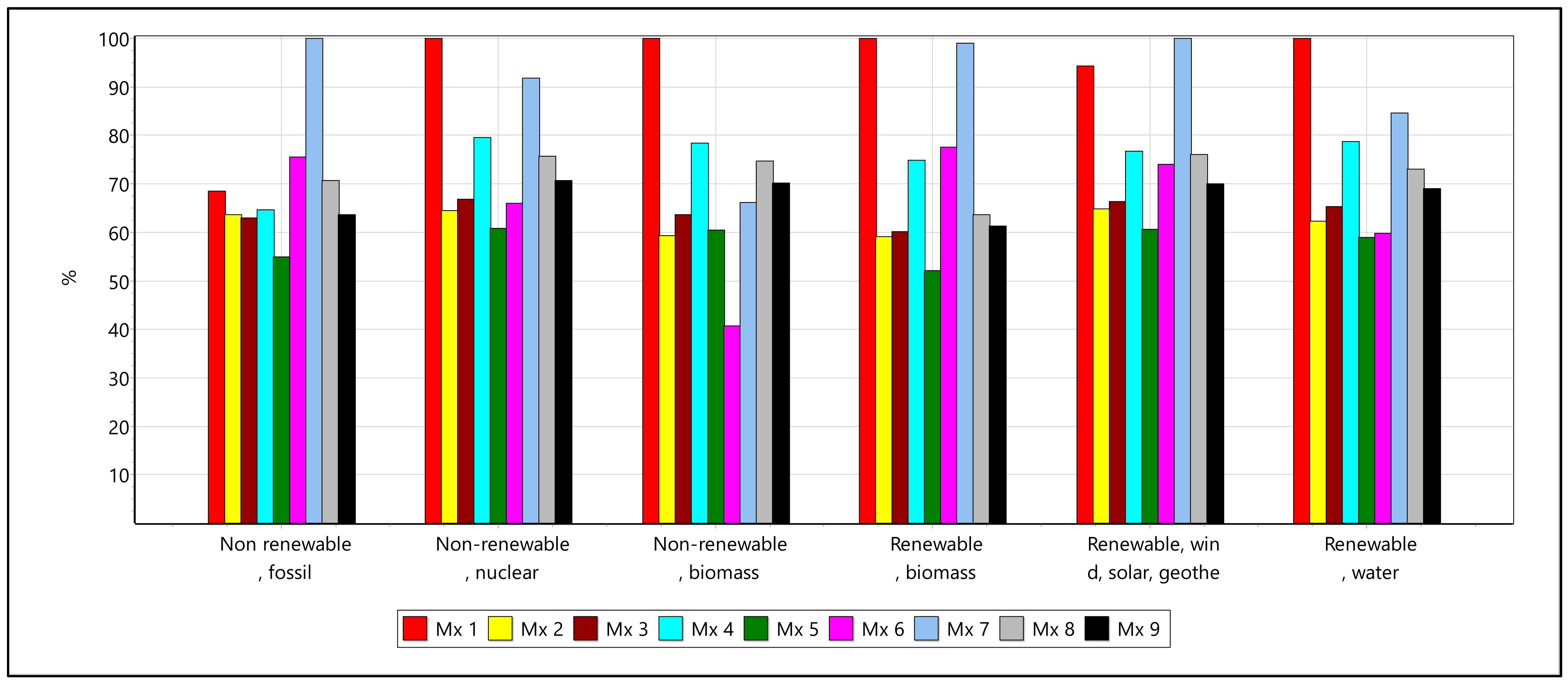

| Landfills (LF) | Total LF | Sanitary LF | Non-Sanitary LF | Dumpsite Waste Received (t/Year) | >20 Hectare | 1–20 Hectare | <1 Hectare |
|---|---|---|---|---|---|---|---|
| Western North | 39 | 12 | 27 | 224,325 | 1 | 30 | 8 |
| Western North | 85 | 34 | 51 | 559,525 | 7 | 44 | 34 |
| Economic Zone Northern | 118 | 33 | 85 | 1,810,029 | 4 | 27 | 87 |
| Economic Zone of Red River Delta | 72 | 23 | 49 | 472,693 | 3 | 49 | 20 |
| Economic Zone of Central | 91 | 50 | 41 | 694,310 | 7 | 69 | 15 |
| Economic Zone of Eastern South, Highland | 113 | 21 | 92 | 1,008,488 | 5 | 81 | 27 |
| Economic Zone of Southern | 33 | 13 | 20 | 1,793,503 | 8 | 16 | 9 |
| Mekong River | 109 | 18 | 91 | 821,828 | 3 | 75 | 31 |
| Total | 660 | 204 | 456 | 7,384,701 | 38 | 391 | 231 |
| Parameter | Methodology | According to Norm |
|---|---|---|
| Water content | The water content was determined based on DIN 18121 Part 1 by oven drying. The sample in its natural state was weighed and then dried together with a pan in the Memmert drying oven at 105 °C. After cooling, the sample was weighed again. The mass difference corresponds to the amount of pore water evaporated by oven drying. | DIN EN ISO 17892-1 |
| Grain density | The test procedure for determining the grain density using a helium pycnometer is regulated by DIN 66137-2: Gas pycnometry. | DIN 66137-2 (analogue to ASTM D854) |
| Grain size distribution | The grain size distribution was determined using a combined dry sieving with a sieving machine (mesh size (mm): 8, 4, 2, 1, 0.5, 0.25, 0.125, and 0.063) and areometer (elutriation) to classify very fine fraction. | DIN 18123 (analogue to Particle-Size Analysis of Soils ASTM D422) |
| Hydraulic permeability | The hydraulic permeability was determined through falling pressure height in a triaxial cell, as given in the procedure of DIN 18130. In parallel, the hydraulic conductivity was estimated from the grain size distribution for validation. | DIN 18130 |
| Loosest layering | The loosest storage was determined with a trowel. The result was calculated as the mean of 5 individual tests. | DIN 18126 (analogue to ASTM D4254) |
| Densest layering | The impact fork test was carried out. The result was calculated as the mean of 3 individual tests. | DIN 18126 (analogue to ASTM D4253) |
| Retention curve (contains information on field capacity, welting point, and air capacity) | The retention curve was determined according to DIN EN ISO 11274:2019. A kaolin box was used to determine the degree of saturation at a pressure of 1.8 pF and 2.5 pF. The pressure plate extractor was used to determine the degree of saturation at a pressure of 4.2 pF. To determine the retention curve, the samples were installed with a dry density of 0.175 g/cm3. | DIN EN ISO 11274 |
| Mixture | Milled Brick (%) | Clay (%) | Fine sand (%) | Bentonite (%) |
|---|---|---|---|---|
| MB 1 | 43 | 54 | 1.5 | 1.5 |
| MB 2 | 54 | 43 | 1.5 | 1.5 |
| MB 3 | 50 | 50 | - | - |
| MB 4 | 75 | 22 | 1.5 | 1.5 |
| MB 5 | 25 | 72 | 1.5 | 1.5 |
| MB 6 | 97 | 0 | 1.5 | 1.5 |
| Mixture | RHA (%) | Milled Brick (%) | Clay (%) |
|---|---|---|---|
| RHA 0 (pure) | 100 | - | - |
| RHA 1 | 20 | 20 | 60 |
| RHA 2 | 40 | 20 | 40 |
| RHA 3 | 40 | 20 | 20 |
| RHA 4 | 20 | - | 80 |
| RHA 5 | 40 | - | 60 |
| RHA 6 | 60 | - | 40 |
| RHA 7 | 80 | - | 20 |
| Materials | Density (t/m3) | Reference |
|---|---|---|
| Clay | 1.76 | [71] |
| Bentonite | 1.50 | [72] |
| Brick Waste | 2.00 | [73] |
| Fly Ash (closely packed) | 1.20 | [74,75] |
| Rice Husk Ash | 2.11 | [76] |
| Unit Process | Changes Made | ||
|---|---|---|---|
| Bentonite quarry operation RoW|APOS, U | Water, unspecified natural origin, VN Electricity, medium voltage (VN)| market for electricity, medium voltage|APOS, U Emissions—Water, VN | Water and Electricity input changed to Vietnam region Water emission changed to Vietnam Region | 30 km |
| Claypit operation RoW|APOS, U | - | - | |
| Sand quarry operation, extraction from river bed IN| APOS, U | Water, unspecified natural origin, VN Electricity, medium voltage (VN)| market for electricity, medium voltage|APOS, UEmissions—Water, VN | Water and Electricity input changed to Vietnam region Water emission changed to Vietnam Region | |
| Treatment of waste brick, recycling RoW|APOS, U | - | - | |
| Market for transport, freight, lorry 16–32 metric ton, EURO4 RoW|APOS, U | |||
| (Coal Ash) Electricity production, hard coal TH| APOS, U | Water, unspecified natural origin, VN Emissions—Water, VN | Water input changed to Vietnam region Water emission changed to Vietnam Region Zero allocation for ash as waste | 65 km |
| (Rice Husk Ash) White rice (raw), at processing/CN Mass | Agri FootPrint—5/zero allocation Ecoinvent—Water, unspecified natural origin, VN Ecoinvent—Emissions—Water, VN | Water, unspecified natural origin, VN Rice, at farm/VN Mass Zero allocation for ash as waste | |
| Market for transport, freight, lorry 16–32 metric ton, EURO4 RoW|APOS, U | |||
| Category Group | Impact Category | Category Indicator |
|---|---|---|
| Climate Change | Global warming potential | kg CO2 eq |
| Depletion of Abiotic Resources | Mineral Resource Scarcity | kg Cu eq |
| Fossil Resource Scarcity | kg oil eq | |
| Acidification | Terrestrial Acidification | kg SO2 eq |
| Eutrophication | Freshwater Eutrophication | kg P eq |
| Particulate Matter | Fine Particulate Matter Formation | kg PM2.5 eq |
| Ozone | Stratospheric Ozone Depletion | kg CFC11 eq |
| Ozone Formation Terrestrial Ecosystem | kg NOx eq | |
| Cumulative energy demand | Cumulative energy consumption | KJ |
| Mixture | w (-) | ρs (g/cm3) | ρPr (g/cm3) | wPr (-) | kf (m/s) | FC (%]) | AC (%) | Feasibility |
|---|---|---|---|---|---|---|---|---|
| MB 1 | 0.0072 | 2.709 | 1.826 | 0.1415 | 1.79 × 10−10 | 22.61 | 4.93 | Class II |
| MB 2 | 0.0072 | 2.709 | 1.791 | 0.1378 | 2.66 × 10−9 | 28.74 | 5.64 | Class I |
| MB 3 | 0.0065 | 2.718 | 1.799 | 0.1393 | 1.14 × 10−9 | 26.30 | 5.77 | Class I |
| MB 4 | 0.0058 | 2.711 | 1.744 | 0.1650 | 1.06 × 10−8 | 38.09 | 5.32 | Not Applicable |
| MB 5 | 0.0078 | 2.715 | 1.791 | 0.1422 | 1.71 × 10−10 | 34.88 | 5.42 | Class II |
| MB 6 | 0.0054 | 2.700 | 1.555 | 0.1891 | 3.69 × 10−7 | 34.95 | 7.28 | Not Applicable |
| Mixture | w (-) | ρs (g/cm3) | ρPr (g/cm3) | wPr (-) | kf (m/s) | FC (%) | AC (%) | Feasibility |
|---|---|---|---|---|---|---|---|---|
| RHA 0 | 0.1848 | 1.655 | 0.184 | 0 | n.m. | 7.64 | 60.50 | Not Applicable |
| RHA 1 | 0.0081 | 2.598 | 1.500 | 0.2155 | 5.05 × 10−10 | 22.70 | 9.35 | Class II |
| RHA 2 | 0.0064 | 2.407 | 1.233 | 0.3125 | 3.43 × 10−9 | 20.87 | 17.16 | Class I |
| RHA 3 | 0.0067 | 2.576 | 1.530 | 0.2065 | 3.56 × 10−10 | 25.07 | 11.22 | Class II |
| RHA 4 | 0.1043 | 2.187 | 1.076 | 0.3405 | 4.47 × 10−10 | 20.10 | 3.75 | Class II |
| RHA 5 | 0.0824 | 2.179 | 0.864 | 0.5148 | 7.39 × 10−9 | 26.97 | 10.61 | Not Applicable |
| RHA 6 | 0.0968 | 2.175 | 0.998 | 0.4030 | 2.04 × 10−8 | 29.11 | 16.67 | Not Applicable |
| RHA 7 | 0.1756 | 1.764 | n.m | n.m | 1.22 × 10−4 | 18.88 | 44.64 | Not Applicable |
| Clay | Bentonite | Milled Brick | Fly Ash | Rice Husk Ash | Sand | |
|---|---|---|---|---|---|---|
| Mix 1 | 97% | 3% | - | - | - | - |
| Mix 2 | 47% | 3% | 50% | - | - | - |
| Mix 3 | 54% | 1.5% | 43% | - | - | 1.5% |
| Mix 4 | 72% | 1.5% | 25% | - | - | 1.5% |
| Mix 5 | 50% | - | - | 50% | - | - |
| Mix 6 | - | 20% | - | 80% | - | - |
| Mix 7 | 20% | 20% | - | - | 60% | - |
| Mix 8 | 60% | - | - | - | 40% | - |
| Mix 9 | 60% | 20% | 20% |
Publisher’s Note: MDPI stays neutral with regard to jurisdictional claims in published maps and institutional affiliations. |
© 2022 by the authors. Licensee MDPI, Basel, Switzerland. This article is an open access article distributed under the terms and conditions of the Creative Commons Attribution (CC BY) license (https://creativecommons.org/licenses/by/4.0/).
Share and Cite
S., N.A.; Anh, L.H.; Thanh, N.T.; Thao, P.T.M.; Schneider, P. Life Cycle Assessment of Substitutive Building Materials for Landfill Capping Systems in Vietnam. Appl. Sci. 2022, 12, 3063. https://doi.org/10.3390/app12063063
S. NA, Anh LH, Thanh NT, Thao PTM, Schneider P. Life Cycle Assessment of Substitutive Building Materials for Landfill Capping Systems in Vietnam. Applied Sciences. 2022; 12(6):3063. https://doi.org/10.3390/app12063063
Chicago/Turabian StyleS., Naveedh Ahmed, Le Hung Anh, Nguyen Trung Thanh, Pham Thi Mai Thao, and Petra Schneider. 2022. "Life Cycle Assessment of Substitutive Building Materials for Landfill Capping Systems in Vietnam" Applied Sciences 12, no. 6: 3063. https://doi.org/10.3390/app12063063
APA StyleS., N. A., Anh, L. H., Thanh, N. T., Thao, P. T. M., & Schneider, P. (2022). Life Cycle Assessment of Substitutive Building Materials for Landfill Capping Systems in Vietnam. Applied Sciences, 12(6), 3063. https://doi.org/10.3390/app12063063









